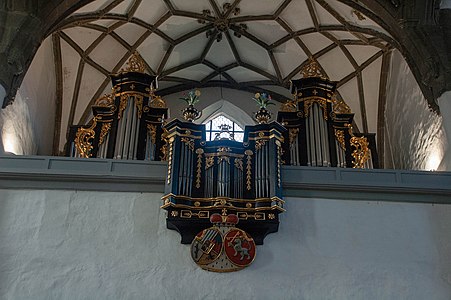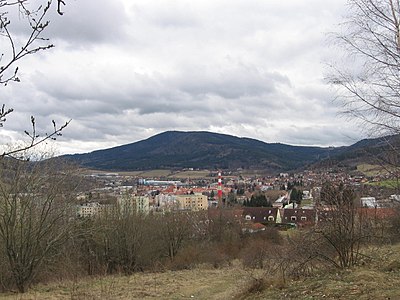GLAM/Newsletter/March 2019/Contents/Czech Republic report
|
Edit-a-thon Prachatice
Edit-a-thon Prachatice, fewer barriers better results

Introduction
Edit-a-thon Prachatice took place in Prachatice, on the south of the Czech Republic March 8th to 10th, 2019 and has officially ended March 31st. It was organised by informal group Via Wiki (users Juandev (main organiser) and Elektracentrum (on site negotiations and preparation)) with the partnership of Prachatice Museum, under the patronage of Ing. Martin Malý, the mayor of the town.
Ten Wikimedians from the whole country had arrived. Most of them were from Prague, two of them from České Budějovice (town close to Prachatice) and one participant was from Brno. Moreover, about four participants have contributed online.
The goal of the project was to cover local topics on Wikipedia and build a local wiki community. This was proposed to the Wikimedia Foundation, which was requested for funding and the funding was received. We set a concrete goal: 45 articles to be edited, at least two new participants to be recruited and two local wiki events to be scheduled. The Wiki participants spent most of the time editing, photographing, helping others and collecting resources for editing. Of course, we haven’t forgotten about Wikidata. Two of the participants were designated to take pictures, one of them directly in the town and the other one around the town and in the countryside.
Participants from out of town were financially supported on transportation, accommodation and refreshment. Prachatice Museum, led by Mgr. Peter Berkovský, accommodated the participants in a room equipped with the internet connection and further provided them with literature sources and other professional support.
Participants have to get to know the place first
The results of the edit-a-thon were following: 134 articles created or improved, 1667 photographs uploaded, 74 new Wikidata items added, 1 new contributor recruited, 4 potential partners gained and 1 future common project planned.
This contribution was not measured by the Programs & Events Dashboard but was rather administered manually. This represented a rather complicated way, but it gave us a deeper insight into the ways of contribution and furthermore, by the means of sending the participant questionnaire post-event, we will be able to improve conditions for future edit-a-thons which in result will make the event more contributive. The results have shown, that rather than having a narrow model, where participants come, sit and edit for two days in a library, it is better to approach a new model, where everybody is free to schedule their work in whichever way they want. This model also seems to be more welcomed by the participants. Understandably the venue with the internet and resources is still available to the participants. Our results show that there are some participants who rather enjoy the traditional model since all of their contributions were made during the editing hours. Others preferred to get in touch with the town on their own, take photographs, collect information resources, rise professional questions to the museum personnel and afterwards do most of their work at home – as they have an extra time till the end of the month. The ways of online contribution were less effective due to the limited time and fewer literature sources available to them. Here we clearly see, that the contribution was almost the same – 68 articles (54 by participants on the site and 14 by participants online) were edited during the event, while the contribution after editing event was slightly lower – 66 articles, including 4 articles from a new local participant. On the other hand, articles that were written after the edit-a-thon usually tend to be longer than those created during the event. Online participants did not contribute after the event itself has ended.
-
Organ in the Church of Saint James the Greater
-
Coat of arms at the Lower Gate Tower
-
House sign
-
Renaissance sgraffito at one of the local houses
-
Light pillbox from pre World War II times
The statistical analysis shows us, that while some participants were merely editing their articles, the others were helping them. One on-site and one online participant have reached a high participation level. Therefore without any previous selection, we ended up with a rather diverse group which created such a fantastic result. There was also a high usage of the photographs taken – 31 %. This could be explained by the fact that most of the photographs taken were taken in order to be implemented into the edited articles and as some of the articles were longer, they in result could contain a higher amount of pictures.
Local participation and the future
On the other hand, the local participation was lower than we expected, even though the local participants had shown a great degree of interest. Therefore after the evaluation of the contributions and the discovery that the open model appears to be more beneficial, it has been applied into the management of local organisations, which brought us a first collaboration that starts in about a month.
With the contribution of local nongovernmental organization KreBul, o.p.s, which targets social problems and provides help to its target audience in their office, we are planning to establish the so-called Wiki Club (or Wikipedia Club) which is going to represent a low barrier way how to integrate interested locals into Wikimedia community. In the beginning, we will show people how to not fear to edit Wikipedia and encourage them to edit lists, for which the contributors will not need so much knowledge when editing an article. In the second phase, we will be moving to articles themselves, providing the participants with Q&A sessions and training. The future will show whether this model will be successful or not.
Hopefully there will be another establishment of cooperation with the local museum. The same museum that has provided us with the venue and had previously realized that the impact of Wikipedia is immense. Traditionally the aim of such an institution is to research and spread information. However, the old ways of spreading information in a world where the role of the Internet is becoming more and more significant, are becoming more complicated and expensive. We are extremely lucky that the museum has provided us with the venue, promised us to release some old photographs from their archives, and shown an interest in further cooperation.
From what has been written so far, one can conclude that Edit-a-thon Prachatice was not an isolated activity, but it rather represented the part and the beginning of a larger project, which was established and scheduled to take place in the area. The negotiations have started about 10 months ago and have brought us two Wikipedia presentations that took place in February and March 2019, the edit-a-thon itself, and concerning the future, there will be a Wiki Club establishment and possible future cooperations. The time invested into the preparations of this edit-a-thon was spent on the detailed choice of topics for editing, clean-up of categories on both Wikipedia and Wikimedia Commons, standardising the names and creating the online database of articles from hard print local professional magazine. Therefore if there will be enough time, we would like to organise another editing event later this year, in which our great team would participate. We expect and hope for many new local contributors to join us and continue to strengthen the local community. In the future, we hope for collaboration between Wikipedia and local organizations such as the library, archive and even the local schools.
-
Main square
-
Countryside
-
Decorative rail of the chapel
-
Prachatice from the hill
| Home | About | Archives | Subscribe | Suggestions | Newsroom |











